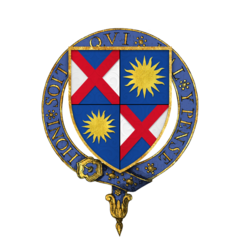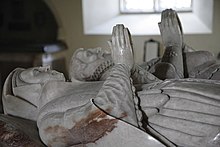John Gage (Tudor politician)
Sir John Gage | |
|---|---|
 Portrait of Sir John Gage, by Hans Holbein the Younger (c. 1535–1540) | |
| Lord Chamberlain | |
| In office 1553–1556 | |
| Monarch | Mary I |
| Preceded by | The Lord Darcy of Chiche |
| Succeeded by | Sir Edward Hastings |
| Personal details | |
| Born | 28 October 1479 Burstow, Surrey, England |
| Died | 18 April 1556 (aged 76) Firle Place, East Sussex, England |
| Resting place | Firle, East Sussex, England |
| Spouse | Philippa Guildford |
| Occupation | Courtier |

Sir John Gage KG (28 October 1479 – 18 April 1556) was an English courtier during the Tudor period. He held a number of offices, including Chancellor of the Duchy of Lancaster (1542–1547), Comptroller of the Household (1540–1547), Constable of the Tower (1540–1556) and Lord Chamberlain (1553–1556).
Early life and family
John Gage was born on 28 October 1479 at Burstow manor in Surrey and baptized at the parish church there on the same day.[1] He was the only son of William Gage and Agnes Bolney.
He married Philippa, daughter of Sir Richard Guildford, in 1502. They were the parents of eight children:[2]
- Sir Edward Gage - married Elizabeth, daughter of John Parker and also Joan, daughter of Sir Richard Sackville.
- James Gage - married Jane, daughter of James Delves and widow of John Bellingham.
- Robert Gage - married Elizabeth, daughter of Nicholas Wilford.
- William Gage - died without issue.
- Alice Gage – married Sir Anthony Browne KG.
- Ann Gage – married John Thatcher.
- Elizabeth Gage – married Sir John Jenyns.
- Cicily Gage - married Sir George Baynham.
Career
An Esquire of the Body to both Henry VII and Henry VIII, he served offices in the Pale of Calais, becoming Comptroller in 1524. After receiving a knighthood in 1525,[3] he moved to the post of Vice-Chamberlain of the Household in 1526, leaving court in 1533. He also represented Sussex three times (1529, 1539 and 1542) in the parliaments of Henry VIII.[3]
He remained active, attending, in 1537, the baptism of Prince Edward and the funeral of Jane Seymour.[3] He returned to favour, and 1540 saw his appointment as Comptroller of the Household, Constable of the Tower and as a Privy Counsellor. In his role as Constable of the Tower, he supervised the arrangements for the execution of Catherine Howard.[4]
In 1541 he became a Knight of the Garter and in 1542 he succeeded as Chancellor of the Duchy of Lancaster.[3] In 1544 he undertook an important role for the invasion of France, organising transport and supplies for the army, and he became a knight banneret.
Present at the funeral of Henry VIII, he was appointed one of the executors of the king's will and a member of Edward VI's Regency Council. Differences soon arose between him and The Duke of Somerset, who expelled him from the council and from his posts of Comptroller and Chancellor when he became Lord Protector in 1547. He re-joined the council, before resigning upon the accession to power of The Earl of Warwick, later Duke of Northumberland. He was suspended as Constable for not supporting Northumberland's attempt to install Lady Jane Grey as Edward's successor. The accession of Mary I saw his restoration as Constable and appointment as Lord Chamberlain. He bore her train at her coronation and at her marriage to Philip of Spain. As Constable, he guarded Princess Elizabeth in 1555; he was described by Heylyn as "her bitter enemy, but more for love of the Pope than for hate of her person".[5]
Death

Gage died at his house, Firle Place, on 18 April 1556, and was buried on 25 April at West Firle Church next to his wife. Their alabaster altar tomb in the north chapel of that church is the work of Garret Johnson of Southwark (1541–1611) and, along with monuments for some other members of their family, was erected in about 1595.[6][7]
His will, made on 20 February 1555/6, was proved at the Prerogative Court of Canterbury on 10 June 1556. A lengthy and detailed household inventory was added as a schedule to the will and points to the wealth and lifestyle that Sir John enjoyed. An introduction and transcription of the inventory has been published.[8]
References
 This article incorporates text from a publication now in the public domain: Bradley, Emily Tennyson (1889). "Gage, John". In Stephen, Leslie (ed.). Dictionary of National Biography. Vol. 20. London: Smith, Elder & Co.
This article incorporates text from a publication now in the public domain: Bradley, Emily Tennyson (1889). "Gage, John". In Stephen, Leslie (ed.). Dictionary of National Biography. Vol. 20. London: Smith, Elder & Co.
- ^ Calendar of Inquisitions Post Mortem, 2nd series, Vol. 2, No. 480
- ^ Gage, John (1822). The History and Antiquities of Hengrave in Suffolk. London. pp. 231–5.
- ^ a b c d Potter, David (January 2010). "Gage, Sir John (1479–1556)". Oxford Dictionary of National Biography. Oxford University Press. doi:10.1093/ref:odnb/10272. Retrieved 12 February 2011. (subscription or UK public library membership required)
- ^ Potter, David (2002). "Sir John Gage, Tudor Courtier and Soldier (1479-1556)". The English Historical Review. 117 (474): 1129. doi:10.1093/ehr/117.474.1109.
- ^ Heylyn, Peter (1849). Robertson, James Craigie (ed.). Ecclesia restaurata; or the History of the Reformation of the Church of England. Vol. 2. Cambridge: Cambridge University Press. p. 259.
- ^ Sussex Parish Churches
- ^ http://www.geograph.org.uk/photo/2897225
- ^ Rice, R Garraway (1892). "The household goods etc. of Sir John Gage of West Firle, Co. Sussex, KG, 1556". Sussex Archaeological Collections. 45: 116–127.
Bibliography
There does not appear to be a biography of Sir John Gage in the form of a book. However, the following lengthy and profusely referenced article provides extensive information about him and discusses his role in contemporary public life:
- Potter, David (2002). "Sir John Gage, Tudor Courtier and Soldier (1479-1556)". The English Historical Review. 117 (474): 1109–1146. doi:10.1093/ehr/117.474.1109.
- 1479 births
- 1556 deaths
- People of the Tudor period
- Chancellors of the Duchy of Lancaster
- Knights Bachelor
- Knights of the Garter
- Members of the Privy Council of England
- English MPs 1529–36
- English MPs 1539–40
- English MPs 1542–44
- English MPs 1545–47
- Esquires of the Body
- Knights banneret of England
- English courtiers
